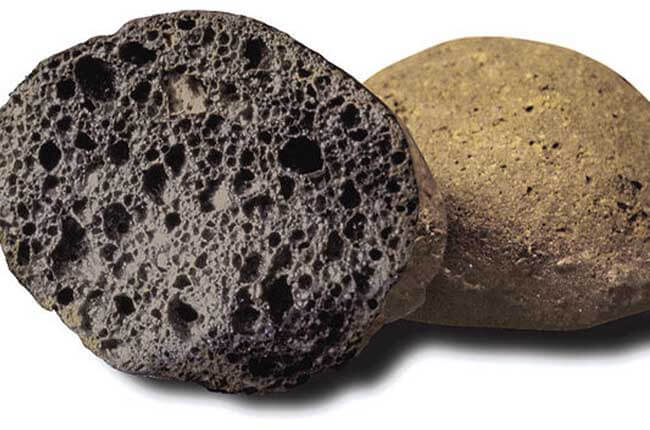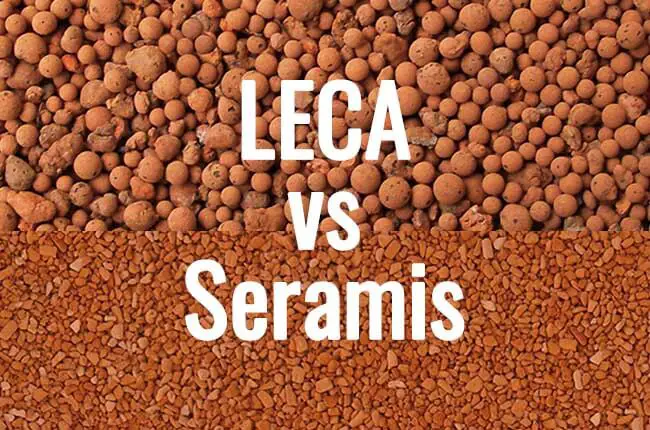LECA and Seramis are becoming increasingly popular as inorganic media for growing orchids in a semi-hydroponic setup. But what is the difference between the two and which is better for growing orchids?
While both are baked clay, LECA has less than half the water absorption and retention capacity than Seramis. A LECA-only substrate can leave the top layer dry, unsuitable for thirsty orchids and damaging to young roots, whereas Seramis may result in molding and root rot. An ideal would be a mix.
1.What is LECA?
LECA is an acronym for Lightweight Expanded Clay Aggregate. It is also known as clay pebbles, clay balls or hydroton.
They are clay heated up to a very high temperature at 2 190 ºF (1 200 ºC) so that gas expands to give them a highly porous honeycomb-like structure.

LECA balls come in different sizes, ranging from 1/8 to 5/8 inch (4 to 16mm) in diameter.
They are a popular choice of inorganic media for a semi-hydroponics setup for epiphytic orchids because they are economical and easily accessible.
You can even buy LECA at some IKEA stores (US$ 5.99 for 5.3 quart).
For online purchase, GROW!T is a good brand with LECA in different sizes.

2.What is Seramis?
Similar to LECA, Seramis is made up of baked expanded clay. It is a German product as it uses clay which is only found in the Westerwald region of Germany.
The clay undergoes a special process to achieve pore volume of over 80%. Then it is dried, broken down, sieved and then fired at a low temperature to further increase its water intention property.
The resulting product is highly porous, with a high capacity to absorb and retain much water.
They come in two grades: large chunks (about half an inch wide) and small granules (small like coffee granules or rice). The granular version is too small and has bad reviews about mold formation and root rot.
Its natural pH is 5.6 to 6.
Seramis is not easy to find outside of Europe. The chunky version can be bought from a German-based shop Orchitop (9.99 Euro for 7 Liter).
A water-retentive alternative to Seramis can be small-grade pumice, lava rocks and kyodama which are discussed in the article on various inorganic media for orchids.
3. Aim and Method of Experiment
To determine the difference between LECA and Seramis, results from an experiment performed by Orchid Room are taken in the analysis. The chunky version of Seramis was used in this experiment.
The aim of experiment is to find out differences between the two media in:
- water absorption capability
- water retention capability
- wicking efficiency
The method of the experiment was:
- First, the media was prewashed to eliminate dust (especially Seramis) and then dried. They are then put into individual cups without drainage holes, with the initial dry weights of LECA and Seramis measured.
- The same amount (150g) of water was added to each cup to soak the media for 24 hours.
- The water was dumped and the media was weighed for checking how much water was absorbed and the water absorption capacity (%).
- The media was then left in pots uncovered in room temperature of around 65 F (19 C) for 7 days to evaporate away any moisture naturally. The media was then weighed again for checking how much of the absorbed water had been lost and thus deducing the water retention capacity.
4. LECA vs Seramis: Comparing their properties
4.1 Water absorption capacity
| LECA | Seramis | |
| (a) Initial dry media weight | 83.9 | 96.2 |
| (b): Wet weight, soaked & drained, g | 105.5 | 165.3 |
| (b) – (a) = (c): Water absorbed, g | 21.6 | 69.1 |
| (c) ÷ (a): Amount of water absorbed relative to dry media weight, % | 26% | 72% |
The results show that LECA can only absorb 26% of its own weight of water, much less than Seramis which can absorb 72% of its own weight.
4.2 Water retention capacity
| LECA | Seramis | |
| Water loss after 7 days | 70% (60% when horticultural grit was added as a top covering layer) | 35% |
| Water retention after 7 days | 30% (40% when horticultural grit was added as a top covering layer) | 65% |
The results show that LECA is not water retentive as they could only retain 30% of the water poured after a week. Although LECA can wick from the reservoir up to the top, water evaporates faster than its wicking efficiency.
In comparison, Seramis is much more water rententive, holding 65% of the water absorbed from a week ago.
4.3 LECA vs. Seramis: Water wicking efficiency
Both LECA and Sermias can wick, enabling water to travel slowly from the reservoir at the bottom up to the top before it evaporates.
This property makes them both a suitable choice for a self-watering or semi-hydroponic system where the media pulls water up from the reservoir in the bottom of the pot by capillary action, thus providing the root zone with constant moisture.
5. LECA vs. Seramis: Which Is Better For Orchids?
Neither LECA nor Seramis is more superior than the other as each has its characteristics which can be good or bad for different environments. Here is a summary of their characteristics:
| LECA | Seramis | |
| Water absorption and retention | Low Can absorb 26% its own weight Can retain 30% of water absorbed after a week | High. Can absorb 72% its own weight Can retain 65% of water absorbed after a week |
| Drainage / air ventilation | Bigger spaces between the LECA balls provide ventilation to the roots | The small clay granules may suffocate orchid roots as water is caught in the small spaces |
| Wicking efficiency | Wicks water well from the bottom to the top | Wicks water well from the bottom to the top |
| Degradability | Do not degrade over time, can be disinfected and reused | Do not degrade over time, can be disinfected and reused |
| Cost | Economical | Expensive |
| Availability | Widely available, even in IKEA, and many online US vendors | Easily available to customers in Europe. US-based customers can purchase from Europe. |
While both are efficient in wicking water from the bottom to the top and do not easily degrade with time, the major difference is with their water absorption and retention capability.
For LECA, a lower water absorption and retention capacity can be an advantage for warm orchid growers (e.g. Phalaenopsis, Cattleya) which has thick roots and need more ventilation than moisture around the roots. Also, the fast drying character would mean a lower risk of root rot in a humid, cold environment.
However, the fast drying character of LECA can be a disadvantage. Moisture in a LECA-only substrate is unevenly distributed with a dry top layer and a layer of humidity trapped in the middle. A dry top layer can leave the roots in the upper part of the pot desiccated and damage new root tips as the porous clay balls draw in moisture from its surroundings. This problem reportedly occurs in both dry and humid climates.
Also, fast evaporation would also imply a higher drop of temperature in the substrate, which can be problematic for a cold environment.
To mitigate the drying nature of LECA, mixing a little bit (e.g. 20%) of the water retentive Seramis especially on the top layer can be beneficial even for orchids, such as Cattleya and Phalaenopsis, which prefer more aeration than moisture.
For Seramis, a high water absorption and retention capacity can be an advantage for cold growers (e.g. Oncidium). Some people have reportedly used 100% Seramis with Oncidiums successfully without any root rot.
The highly water retentive aspect of Seramis can also be a problem for humid environments and for orchids that require more aeration, resulting in molding, algae formation and root rot.
To get the best of both worlds, the drying quality of LECA can be mitigated by mixing it with the water retentive Seramis to provide an ideal airy and moist environment around the root zone.
To prevent mold formation (caused by Seramis) and a dry layer (caused by LECA) on the top of the media, the best would be top dressing it with a layer of non-porous or non-wicking river rocks or polished pebbles.
Also, the water retentive Seramis would be a good replacement for pebbles on a humidity tray.
Conclusion
To sum up, LECA is much more drying than Seramis in their ability to absorb and retain water. Whether one is an ideal media for growing orchids heavily depends on the growing conditions (humidity, temperature, air ventilation, pot size, pot material, number of drainage holes) and the water needs of the orchid (orchid species, plant size).
But, a mix between a more drying media such as LECA and a water retentive media like Seramis is always a good starting point for orchid growers. Gardeners can start from a 20-80 LECA to Seramis mix for a more water retentive media or 80-20 LECA to Seramis mix for a more airy media and then slowly go up and down the scale. An ideal ratio between the two media has to be determined through experimentation through time.
Happy growing!
Related
4 Ways to Prevent Algae in Semi-Hydroponics
Growing Orchids Without A Pot? (6 Ways To Go Bare-Rooted)
Can You Reuse Sphagnum Moss? (Explained)
Growing Orchids with Live Moss? (Pros & Cons Examined)
Photo credits
Leca67, Public domain, via Wikimedia Commons
- Top 6 Drip Irrigation Systems for Raised Beds (2025) - January 31, 2025
- Top 10 Orchid Fertilizers: A Comprehensive Review (2025) - January 16, 2025
- Top 6 Slow-Release Fertilizers for Houseplants & Veggies (2025) - January 15, 2025


